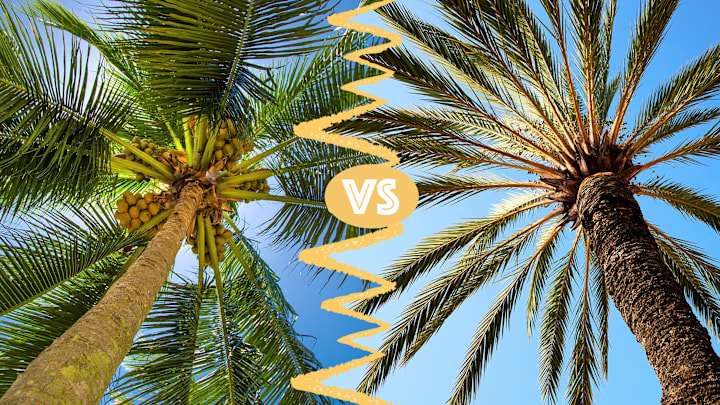If you’re driving along a tropical coast, it can be easy for one of the area’s tall, fan-leafed trees to catch your eye and make you start daydreaming about all things coconut.
Because of their similar characteristics, many people mistake palm and coconut trees for one another. But not every palm tree is a coconut tree. Here are some tips on how to spot the differences between the plants.
Are coconut trees palm trees?
Yes, a coconut tree is a palm tree. There are actually around 2600 types of palm trees in the family Aracaceae; coconut trees (Cocos nucifera) are the only ones in the genus Cocos. Neither coconut trees nor palm trees are real trees—they’re monocots, a group of plants that includes grasses, orchids, corn, and more.
The plants don’t have the same kind of wood and bark as other trees. You won’t find any tree rings inside their trunks, which aren’t even trunks at all but are actually stems. Their leaves are either fan-shaped or feather-shaped, depending on the species.
Identifying Palm Trees vs. Coconut Trees
The first step for identifying the type of tree you’re looking at is to determine its size. A palm tree can be anything from a 6-foot houseplant to an impressive 200-foot beach giant. Coconut trees, meanwhile, have a more narrow range; a full-grown tree always stands somewhere between 30 and 100 feet (dwarf plants will of course be smaller).
Location is another big clue. Coconut trees are fairly selective about where they grow—they need tropical conditions with high humidity and no signs of frost. Because palm trees refers to such a wide variety of species, you can spot them in deserts, rainforests, and along temperate coasts.
Another big difference between coconut trees and palm trees is how they’re used. The obvious product that coconut trees produce is—you guessed it—coconuts. These drupes are known for their delicious meat and the oil that can be extracted from them, and their shells can even be used to create charcoal.
Palm trees are a versatile group, as there are many different kinds. Some species produce other fruit like dates and açaí berries; others are harvested for palm oil; and some are even used for reforestation efforts because of their knack for quick and simple growth.
Read More About Plants:
Have you got a Big Question you'd like us to answer? If so, let us know by emailing us at bigquestions@mentalfloss.com.
